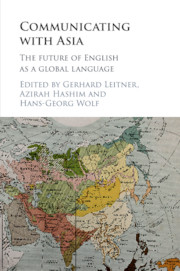Book contents
- Communicating with Asia
- Communicating with Asia
- Copyright page
- Contents
- Figures
- Tables
- Contributors
- Book part
- Communicating with Asia: introduction
- Part I English in selected regional and national habitats with a glance at the role of outward-bound communication needs
- 1 The development of English in Pakistan
- 2 English for Japan: in the cultural context of the East Asian Expanding Circle
- 3 Convergence and divergence of English in Malaysia and Singapore
- 4 Indian English prosody
- 5 Charting the endonormative stabilization of Singapore English
- 6 Arabic in contact with English and Malay in Malaysia
- 7 Preposition stranding and pied-piping in Philippine English: a corpus-based study
- 8 The Americanization of the phonology of Asian Englishes: evidence from Singapore
- 9 Postcolonial and learner Englishes in Southeast Asia: implications for international communication
- Part II Major other languages in Asia, their international status and impact on education
- Part III Wider perspectives
- Bibliography
- Index
9 - Postcolonial and learner Englishes in Southeast Asia: implications for international communication
from Part I - English in selected regional and national habitats with a glance at the role of outward-bound communication needs
Published online by Cambridge University Press: 05 January 2016
- Communicating with Asia
- Communicating with Asia
- Copyright page
- Contents
- Figures
- Tables
- Contributors
- Book part
- Communicating with Asia: introduction
- Part I English in selected regional and national habitats with a glance at the role of outward-bound communication needs
- 1 The development of English in Pakistan
- 2 English for Japan: in the cultural context of the East Asian Expanding Circle
- 3 Convergence and divergence of English in Malaysia and Singapore
- 4 Indian English prosody
- 5 Charting the endonormative stabilization of Singapore English
- 6 Arabic in contact with English and Malay in Malaysia
- 7 Preposition stranding and pied-piping in Philippine English: a corpus-based study
- 8 The Americanization of the phonology of Asian Englishes: evidence from Singapore
- 9 Postcolonial and learner Englishes in Southeast Asia: implications for international communication
- Part II Major other languages in Asia, their international status and impact on education
- Part III Wider perspectives
- Bibliography
- Index
Summary
This chapter compares two postcolonial varieties, Singapore English and Malaysian English, with a neighboring learner variety from Indonesia, all of which share Malay as a common substrate language. The comparative analysis reveals a common inventory of nonstandard features, albeit with differences such as features unique to a particular variety, or a wider range of realizations of a given feature in the learner variety. In terms of frequency, the learner variety displays higher levels of nonstandard morphology and syntax, even when accounting for register variation. The implications for communicating with Asia pertain to more predictable nonstandard features in the postcolonial varieties due to the relatively narrow range of realizations of features, as well as the ability of speakers of postcolonial varieties to accommodate their language production toward standard English, which is not the case for the Indonesian learners.
- Type
- Chapter
- Information
- Communicating with AsiaThe Future of English as a Global Language, pp. 135 - 152Publisher: Cambridge University PressPrint publication year: 2016

